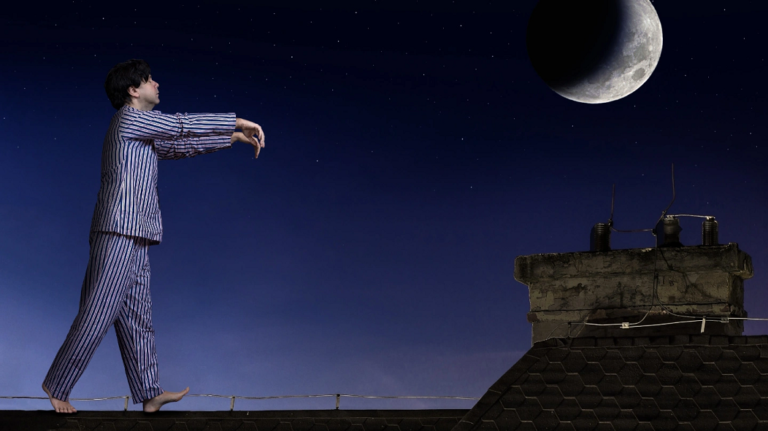
What Is Sleepwalking?
Sleepwalking, also termed somnambulism, is a disorder in which a person briefly wakes up during sleep and may feel disoriented or groggy for a few minutes. It is a common parasomnia that usually occurs during the first part of the night.
During a sleepwalking episode, people carry out complex activities while not fully being fully aware of them.
Sleepwalking once in a while is not something to worry about and usually does not indicate a serious disorder. However, sometimes, it can be a symptom of other underlying issues. Sleepwalkers typically do not perform dangerous activities.
But precautions should be taken to prevent severe injuries such as climbing out of the window or falling down stairs.
Although the chances of this sleeping disorder are significantly higher in children, about 2 percent of adults have also been reported to have a sleepwalking episode beyond their childhood years.
Here’s what you need to know about sleepwalking and how you can control this condition.
Symptoms of Sleepwalking
When people sleepwalk, they can look at you with their eyes open while not recognizing you because they are actually asleep.
They may also get up or perform unusual activities such as talking unclearly, moving furniture, and dressing or undressing. Sometimes, during a sleepwalking episode, people even drive a car.
Symptoms of sleepwalking generally include:
- Acting disoriented when the person wakes up from sleep.
- Showing aggressive behavior.
- Having an unconscious look on the face.
- Not remembering anything about the sleepwalking episode when a person wakes up.
- Talking and saying ambiguous things that do not make sense.
Causes of Sleepwalking
Sleepwalking is a relatively common disorder, and most people who suffer from it do not need any serious treatment. But sometimes, this condition may be linked to your mental health, which must be addressed.
Here are some common contributing factors to sleepwalking:
- Hereditary factors.
- Lack of sleep or extreme fatigue.
- Interrupted sleep.
- Illness or fever.
- Certain medications, such as sleeping pills.
- Stress, anxiety.
- Going to sleep with a full bladder.
- Changes in the sleep environment.
- Migraines.
- Head injuries.
What Are the Risk Factors for Sleepwalking?
Sleepwalking, if associated with any underlying disorder, can ultimately result in serious health consequences. If a person trips or collides with something while sleepwalking, severe injuries can also occur.
Moreover, things like mishandling sharp objects or trying to drive a car during an episode can be life-threatening. Such violent behaviors during a sleepwalking episode can harm the sleepwalker as well as the people nearby.
Diagnosis of Sleepwalking
In order to diagnose sleepwalking, healthcare providers usually review the medical history and symptoms of their patients. The evaluation process may include:
-
Physical Exam
Doctors generally perform a physical exam to determine any conditions that may be mistaken for sleepwalking, such as seizures or panic attacks.
-
Discussion of Symptoms
If the patient’s sleep partner comes to the appointment, doctors usually ask them about their sleeping behaviors or ask patients and their partners to fill out a questionnaire about their sleeping patterns.
-
Polysomnography (Nocturnal Sleep Study)
Sometimes, doctors recommend their patients to sleep overnight in a lab. During this process, sensors will be placed on the patient’s body that will record and monitor blood oxygen levels, brain waves, breathing, and heart rate, as well as body movements while they sleep.
How to Treat Sleepwalking?
If sleepwalking leads to severe injuries, causes harm to family members, or results in embarrassment for the person who sleepwalks, medical help is required.
Treatments for this disorder typically focus on eliminating the triggers and promoting safety measures.
-
Medical Treatments:
Medical treatment is recommended if sleepwalking is induced by certain underlying conditions, such as obstructive sleep apnea, seizures, gastroesophageal reflux, or periodic leg movements. Sleepwalking episodes stop once the underlying medical condition is managed.
Medications may also be necessary if the sleepwalker is at risk of serious injuries and other treatment options have proved ineffective.
-
Other Sleepwalking Treatment Options:
For people who suffer from a long-term sleepwalking disorder, doctors may suggest procedures like anticipatory awakenings, relaxation techniques, and mental imagery to them.
During anticipatory awakenings, a child or a person is awakened approximately 15 to 20 minutes before the usual time of the episode and then is kept awake through the time during which the episodes take place.
How Does Sleepwalking Work?
Conclusion
Sleepwalking episodes usually reduce as children get older and do not indicate a serious disorder. However, in some instances, they might be a reason for any underlying medical condition that needs to be addressed.
People are usually advised to visit their doctor and discuss their condition if they exhibit other symptoms, like if sleepwalking is frequent or persistent or if they do disruptive activities while sleepwalking and are completely unaware of them.
FAQs:
Is Sleepwalking a Mental Disorder?
Sleepwalking is relatively more common among children than adults and often occurs due to hereditary factors. But sometimes, it can also be induced due to sleep deprivation or stress. Other conditions, such as mental health disorders and depression, are also linked with this condition.
Is Sleepwalking Serious?
Sleepwalking usually outgrows during the teen years, and incidents occurring during sleepwalking don’t signal severe problems or need treatment.
However, frequent sleepwalking episodes may suggest an underlying disorder or require medical assistance.
Do I Need to Worry If My Child Sleepwalks?
Sleepwalking can also occur in completely healthy children and is not usually a matter of huge concern. It most commonly takes place during the first stage of sleep.
If your child suffers from recurrent sleepwalking episodes, make your home secure and ensure that your child has a regular sleep schedule.
If these episodes lead to severe injuries or become consistent, you should then consult your healthcare provider.
